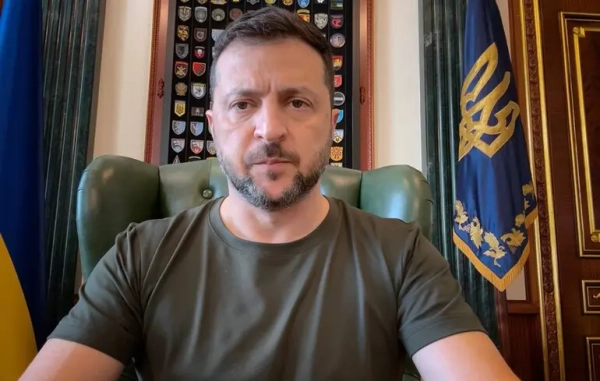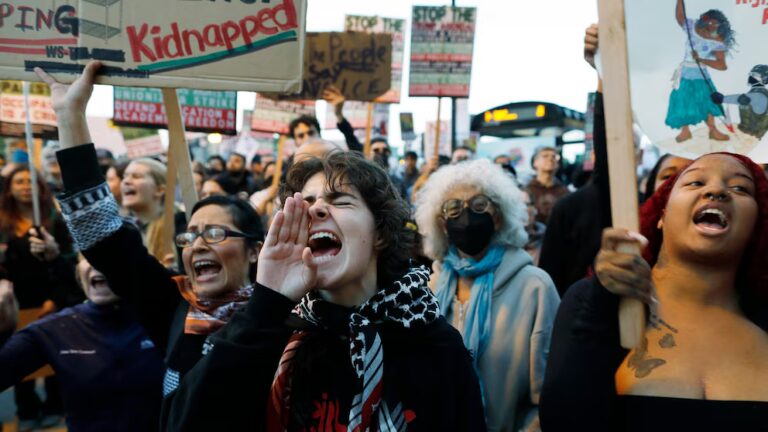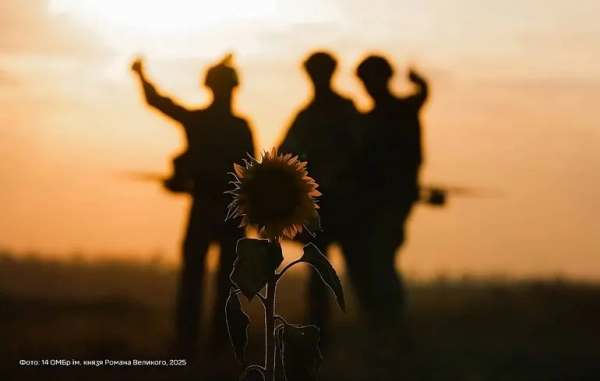A major military shake-up comes amid a fight in Congress over US funding for Ukraine.

Ukrainian President Volodymyr Zelenskyy attends a flag-hoisting ceremony in Izium after the Ukrainian forces took control of the city from the Russian forces in Kharkiv, Ukraine, on September 14, 2022. Metin AktaÅ/Anadolu Agency via Getty Images
Ukraine’s military underwent a major leadership shake-up this week, a decision that President Volodymyr Zelenskyy framed as a reset for the country’s stalled war effort.
On Thursday, Zelenskyy announced that he’d be replacing General Valery Zaluzhny as the military’s leader after the two clashed over whether to back a new conscription push as well as how to frame the war’s lack of progress to the public. In his stead, Zelenskyy has named Colonel-General Oleksandr Syrskyi, the head of the military’s ground forces, as the country’s new commander-in-chief. Syrskyi is known for being a seasoned military leader who’s also been criticized for a willingness to put his troops at risk, so much so that some soldiers colloquially refer to him as the “butcher.”
This change comes at a crucial time for Ukraine’s war with Russia, which is nearly in its third year. While Ukraine had a string of early successes, including surprising the world by holding off an onslaught against Kyiv and retaking some territory in the summer of that year, its progress has slowed due to Russia’s entrenchment, dwindling funds, and limited manpower and weaponry. Currently, Ukraine is still waiting on the US Congress to approve another $60 billion in military aid — a critical infusion of funding — and conservatives have balked at doing so.
All those issues mean replacing the country’s top general is unlikely to result in significant changes to Ukraine’s existing trajectory, and there may be elements of Syrskyi’s demonstrated style so far that worsen soldiers’ morale.
Zelenskyy described the decision to switch commanders-in-chief at this point as fueled, in part, by a need for “effective changes in the basis of our defense,” so Ukraine can be successful moving forward. Beyond Zelenskyy’s strategic disagreements with Zaluzhny, some experts believe the president saw the general, who was quite popular among Ukrainians, as a political threat.
“During wartime, you want the president of the country and the top military chief to be working hand in glove and that did not seem to have been the case between the two of them,” Charles Kupchan, a senior fellow at the Council on Foreign Relations, told Vox.
The shift to Syrskyi means Ukraine now has a military commander who is much more closely aligned with Zelenskyy, including any goals he has of launching more high-profile assaults this coming year.
Who is Syrskyi?
Oleksandr Syrskyi is an experienced Ukrainian military leader who has led the country’s ground troops since 2019. In some ways, he’s seen by political experts as the logical Zaluzhny replacement given his extensive military expertise. He oversaw Ukraine’s success in Kyiv as well as a victory the country achieved in a 2022 counteroffensive in Kharkiv.
At the same time, his pick has been controversial among soldiers because of how he handled a battle in the Ukrainian city of Bakhmut, which lasted for more than nine months. That battle resulted in thousands of casualties and Russia ultimately taking the city. Syrskyi’s decision to stay in Bakhmut was scrutinized given how many people Ukraine lost and questions over whether the city was strategically important enough to justify those casualties.
Syrskyi reportedly argued that the losses were acceptable because Ukraine killed far more Russians in the battle for Bakhmut than it lost. Many of his troops disagreed, however, and his strategy has since led some soldiers to give him some less-than-flattering nicknames.
“One hundred percent of [my subordinates] don’t respect him because they don’t think he counts soldiers’ lives,” one high-ranking Ukrainian official told the Washington Post.
If Zaluzhny was seen as disagreeing with Zelenskyy on strategic goals, Syrskyi is viewed as someone who is more closely aligned with him, in a way that some soldiers are wary of. As one major in Eastern Ukraine told the Post, Zelenskyy is known for wanting splashier wins, which could come at soldiers’ expense. Given Syrskyi’s record and alignment with Zelenskyy, that major feared he’d be less likely to try to fight the president on these ideas than his predecessor — a worry shared by others in the military.
Syrskyi seemed to try to acknowledge soldiers’ morale in his first statements. In a Telegram post after his appointment, he said he is focused on ensuring that forces at the front lines will have a chance at “restoration” and that he is committed to investing in technologies like drones. “New tasks are on the agenda,” he wrote.
Why is Zelenskyy shaking things up now?
Zaluzhny has been part of Ukraine’s military operation since Russia invaded Ukraine in February 2022. Nicknamed the “Iron General,” he’s widely respected in Ukrainian society.
As Ukraine’s progress in the war has stalled, US military leadership has criticized Ukrainian tactics, with some indicating that the Ukrainians were too risk-averse and had failed to utilize complex approaches, according to the Financial Times. Ukrainian officials and other experts have pushed back against that characterization. For example, Michael Kofman, director of the Russia Studies Program at CNA, and Rob Lee, senior fellow in the Foreign Policy Research Institute’s Eurasia Program, argued in a report for War on the Rocks that although insufficient tactical assistance — notably airpower — is part of Ukraine’s problem, an insufficient Western understanding of the battlefield hasn’t helped either.
Ukraine had hoped to turn the tide of the war in a much-touted June offensive. Instead, the battlefield returned to a state of attrition, with Ukraine “focused on reconstitution and digging in to defend against continued Russian attacks” amid diminishing Western reserves, according to Kofman, Lee, and Dara Massicot, senior fellow in the Russia and Eurasia Program at the Carnegie Endowment for International Peace.
In December, Russia and Ukraine traded drone attacks, with Russia targeting critical and civilian infrastructure as well as Ukraine’s defense industrial facilities in an attempt to degrade Ukraine’s ability to arm itself. Ukraine has tried to expand its defense industrial base amid wavering support from the international community, and especially its main military supporter, the US.
Those setbacks have left Ukraine with few options in an existential battle in which Russia is refusing to back down.
Mykhailo Podolyak, a Ukrainian politician and adviser to Zelenskyy’s office, wrote on his Telegram channel Thursday that the personnel change was “due to the need to review the tactics of actions” in the June offensive, which “did not fully ensure the proper result.” Podolyak also pointed to “the need to prevent stagnation on the front line, which negatively affects public sentiment, to find new functional and high-tech solutions” on the battlefield.
Beyond military issues, political concerns are also part of the shake-up. The rift between Zelenskyy and Zaluzhny is the most significant political conflict yet during the nearly two-year war. Overall, Ukraine’s political class and population have presented a united front in the face of Russia’s attacks, but some cracks are starting to show.
For example, 2024 presidential elections have been postponed due to the war; though “an overwhelming majority of Ukrainians understand that it doesn’t make sense to have elections right now,” Andrew D’Anieri, a resident fellow at the Atlantic Council’s Eurasia Center, said, not everyone agrees. There is particular tension about the delay between the president’s office and Ukraine’s mayors, particularly Vitali Klitschko of Kyiv.
The disagreement between Zelenskyy and the military leadership “is very frustrating for the government,” Simon Schlegel, senior Ukraine analyst at the International Crisis Group. “The main strength of [the Ukrainian] government has been its strong communication both with international partners, whose support is so important, but also with its own population. And losing a grip on that, I think that was one of the main drivers behind this decision.”
Essentially, Zaluzhny’s departure is meant to ensure unity is maintained — not just between politicians and the populace but among the top levels of Zelenskyy’s administration.
Will Syrskyi turn things around?
Both Zaluzhny and Syrskyi are respected leaders and tacticians, but the new leadership is unlikely to dramatically change battlefield dynamics — and that may not even be the purpose of the shake-up.
Amid the drone proliferation on the battlefield, Zaluzhny publicly called for more investment into advanced technology, as well as for more aggressive legislation around mobilization that would have expanded conscription to offset Ukraine’s battlefield losses and Ukrainian troops’ overextension.
Zelenskyy has tried to maintain an optimistic outlook about the war, both for the sake of Ukrainians and to garner support from the international community, the Associated Press reported in late January, while Zaluzhny took a darker view of the conflict. The two also disagreed about mobilization tactics — and that disjunction, according to Schlegel, may not improve under Syrskyi’s leadership.
“Zelenskyy has always underlined that he doesn’t want to sacrifice soldiers if he can save them, and I think that was one of the main sources of tension between Zelenskyy and Zaluzhny,” he told Vox. “It’s probably also going to be a source of tension between Zelenskyy and Syrskyi — that army leadership wants more resources and more human resources, and the government has only so much.”
In 2024, Ukraine’s tactics will largely be defensive, Schlegel said. On the battlefield, this will consist of building fortified defensive positions — like underground bunkers and tunnels, as Kofman, Lee, and Massicot write — while building up tactical capacity to make the most of remaining Western weaponry, ensuring greater mobilization of troops, and improving and scaling up training programs with the support of Western forces.
Significant wins will be difficult to accomplish without sustained Western support. The European Union recently approved a 50 billion euro support package for Ukraine, but that won’t be enough to make up the difference should Republicans in Congress continue to hold up military aid to Ukraine or refuse to supply it altogether.
Sourse: vox.com






